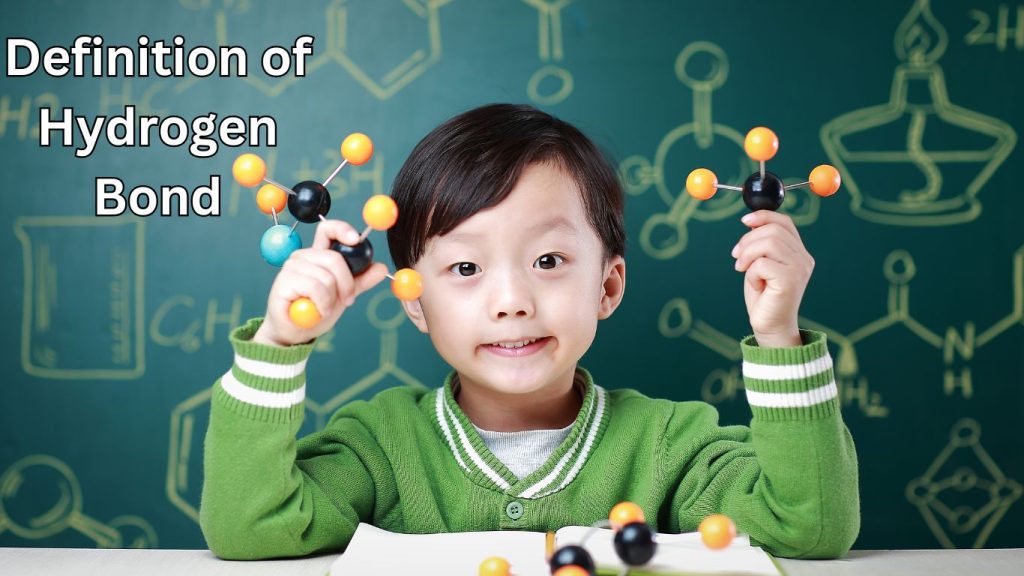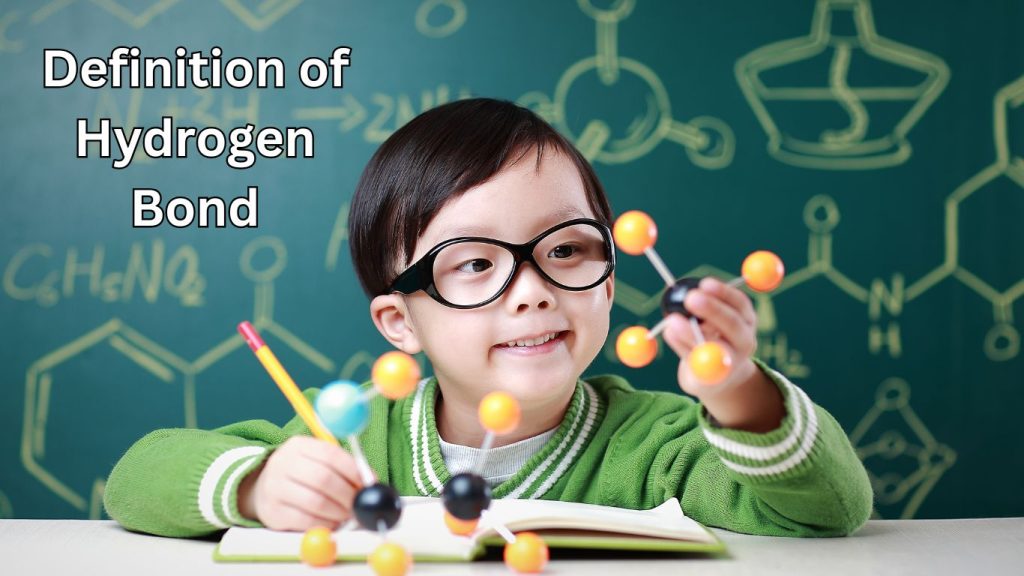Here is the Definition of Hydrogen Bond. This bond is a weak chemical bond formed between a hydrogen atom and an electronegative atom.
Understanding hydrogen bonds is essential for fields ranging from biochemistry to environmental science. These bonds are central to water’s unique properties, influencing its high boiling point and surface tension. This bond is significant in many biological molecules. Hydrogen bonds are crucial in maintaining structure and function within biological molecules, such as DNA and proteins.
They facilitate the intricate folding patterns of proteins and the base pairing in DNA. Although the hydrogen bond may be weaker than covalent or ionic bonds, its ability to dictate the behavior of molecules makes it a vital concept in chemistry and biology. Researchers continue to study hydrogen bonding to unlock further applications in material sciences, pharmaceuticals, and nanotechnology.

Learn more about What is an Ionic Bond in the main guide.
Understanding The Basics Of Hydrogen Bonds
Delving into the intricate world of chemistry, Understanding the Basics of Hydrogen Bonds becomes a fundamental stepping stone. These specific types of bonds play a crucial role in many biological processes and are essential for various substances’ stability and unique properties.
The Concept Of Intermolecular Forces
Intermolecular forces are the forces of attraction or repulsion that act between neighboring particles (atoms, molecules, or ions). They are fundamental to the behavior of substances and dictate phase states, boiling points, and melting points. Among these forces, the hydrogen bond is a unique and significant interaction that occurs in many everyday chemical systems.
Characteristics Of Hydrogen Bonds
Hydrogen bonds exhibit several distinct characteristics:
- Directionality: Unlike other intermolecular forces, hydrogen bonds tend to be highly directional, favoring specific geometric arrangements.
- Strength: They are stronger than van der Waals forces but weaker than covalent and ionic bonds, typically with bond strength ranging from 4 – 40 kJ/mol.
- Short-range effect: The effects of hydrogen bonding are pronounced at short distances but decrease rapidly over longer ranges.
- Dipole-dipole interactions often occur when a hydrogen atom covalently bonded to a highly electronegative atom, such as oxygen, nitrogen, or fluorine, interacts with another electronegative atom.
Comparison With Other Types Of Bonds
| Bond Type | Characteristic | Relative Strength |
|---|---|---|
| Covalent Bonds | Electron sharing between atoms. | Very Strong |
| Hydrogen Bonds | Interaction involving a hydrogen atom and a more electronegative atom. | Moderate |
| Van der Waals Forces | Includes induced dipole interactions and London dispersion forces. | Weak |
| Ionic Bonds | Electrostatic attraction between oppositely charged ions. | Strong |
In comparison, a hydrogen bond, while versatile, sits in a unique niche between the strength of covalent bonds and Van der Waals forces. It defines a form of ‘in-between’ that is neither too strong nor too ephemeral, leading to its prominent role in dictating the structure and function of complex molecules like DNA and proteins.
The Role Of Hydrogen Bonds In Nature
The intricate dance of atoms and molecules is choreographed by a myriad of forces, among which hydrogen bonds take center stage. Hydrogen bonds are essential for the intricate tapestry of life and the peculiar behaviors of many substances that are crucial for the survival of ecosystems. Understanding their role reveals a world where molecular partnerships are key to stability and function.
Hydrogen Bonding In Water
Water, the cradle of life, owes its remarkable properties to hydrogen bonds. These invisible links make water a universal solvent and play a pivotal role in:
- Surface tension – Provides the ability for insects to glide across water surfaces.
- High specific heat – Enables water to absorb heat with minimal temperature increase, critical for climate regulation.
- Density anomaly: Ice floats on water due to its expanded molecular structure caused by hydrogen bonds, safeguarding aquatic life during freezing winters.
Importance In Biological Structures
In biological realms, hydrogen bonds are the architects of life. They meticulously shape:
- The double helix structure of DNA – maintaining genetic blueprints with precision.
- Protein folding – vital for the proper function of enzymes and antibodies.
Without hydrogen bonds, the integrity of these structures would collapse, unraveling life’s complex machinery.
Influence On Physical Properties Of Compounds
Hydrogen bonds exert a profound influence on the physical properties of compounds, significantly affecting:
| Property | Impact |
|---|---|
| Boiling and Melting Points | Molecules with hydrogen bonds require more energy to change states, resulting in higher boiling and melting points. |
| Solubility | Substances capable of hydrogen bonding tend to dissolve well in polar solvents like water, facilitating numerous biological processes. |
| Viscosity | The interconnectedness due to hydrogen bonds adds to resistance against flow, influencing the viscosity of liquids. |
The dexterity of hydrogen bonds in modulating such traits underscores their paramount importance in nature’s design code.
Hydrogen Bonding In Scientific Research And Applications
The intricate dance of molecular interactions holds the secrets to countless scientific phenomena, and central to this dance is the hydrogen bond. This seemingly modest player punches well above its weight in the molecular world, contributing to biomolecular structures and materials’ stability, functionality, and specificity. Researchers continuously uncover the expansive implications of hydrogen bonding, leading to groundbreaking developments across various fields. In this article, we delve into how hydrogen bonds are not just a subject of academic fascination but a cornerstone of innovative scientific application.
Advancements In Drug Design
In pharmaceuticals, the role of hydrogen bonds is pivotal. Hydrogen bonds are instrumental in drug-target interactions, dictating the efficacy and specificity of many drugs. Recent achievements in drug design reveal a trend toward manipulating hydrogen bonds to improve drug performance. By refining these interactions, scientists can enhance drug potency and reduce adverse effects, which are major goals in pharmacology.
- Increased Affinity: Drugs with optimized hydrogen bonding interactions demonstrate an increased affinity towards their targets, elevating treatment effectiveness.
- Drug Stability: Tailoring drugs to form stable hydrogen bonds with their biological targets ensures effectiveness and improved drug lifespan.
- Selectivity: Precision in hydrogen bond placement allows for the design of drugs that selectively bind to desired receptors, mitigating side effects.
Hydrogen Bonds In Material Science
Material science is revolutionizing, thanks partly to our understanding of hydrogen bonds. These bonds contribute significantly to the development of innovative materials with unique properties. Whether it’s enhancing flexibility, strength, or conductivity, hydrogen bonds play a defining role.
| Material Type | Hydrogen Bond Contribution |
|---|---|
| Polymers | Improves elasticity and tensile strength |
| Supramolecular Assemblies | Enables reversible assembly for adaptive materials |
| Hydrogels | Facilitates self-healing properties and responsiveness to stimuli |
Future Directions For Hydrogen Bond Research
The ever-evolving landscape of hydrogen bond research promises an exciting future filled with scientific innovations. As researchers probe deeper into the quantum mechanics of hydrogen bonding and develop more sophisticated computational models, our grasp of these critical interactions will only strengthen.
- Elucidating the quantum characteristics of hydrogen bonds will lead to more precise molecular dynamics modeling.
- Advanced computational techniques are expected to offer unprecedented resolution in predicting hydrogen bonding behavior.
- Cross-disciplinary research likely will pave the way for novel applications leveraging hydrogen bonds, from nanotechnology to environmental science. Google Maps.
Frequently Asked Questions For Definition Of Hydrogen Bond
What Is A Hydrogen Bond Easy Definition?
A hydrogen bond is an electrostatic attraction between two polar groups in which a hydrogen atom covalently bonds to a highly electronegative atom, such as oxygen or nitrogen.
What Is A Hydrogen Bond Children’s Definition?
A hydrogen bond is a special connection where a hydrogen atom links to a stronger atom, like oxygen, in another molecule. This bond is like a magnetic attraction, helping molecules stick together.
What Is A Hydrogen Bond Quizlet?
A hydrogen bond is a weak attraction between a hydrogen atom and a neighboring electronegative atom. It is often found in water molecules and organic compounds. Quizlet offers flashcards and study tools to help learners understand this concept.
Which Of The Following Is An Example Of A Hydrogen Bond?
An example of a hydrogen bond is the attraction between one water molecule’s hydrogen atom and another’s oxygen atom.
Conclusion
Understanding hydrogen bonds is essential to grasping the subtleties of chemical reactions and biology. These powerful but not unbreakable forces play a crucial role at the molecular level. Grasping their function can unveil much about the intricacies of life and the material world.
Always remember that the small-scale interactions of hydrogen bonds significantly impact the world we see.
